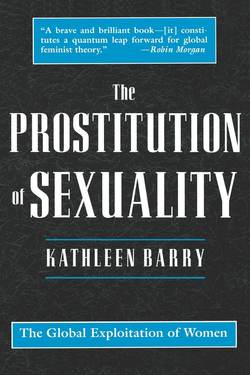Читать книгу The Prostitution of Sexuality - Kathleen Barry - Страница 14
На сайте Литреса книга снята с продажи.
2 Sexual Power
ОглавлениеLisa Mamac, born in a rural farming village in the Philippines, tried to escape the inevitability of marrying there and raising her own family in the poverty in which she grew up. Like many women moving from rural to urban areas as their country is industrializing, Lisa left her village for a large city with plans to go to school. Rural to urban migration socially dislocates women and girls as patriarchal power in traditional societies provides almost no possibilities for women outside of marriage or their family. Under these conditions women are made particularly vulnerable to sexual exploitation. Away from home and on her own, Lisa fell in love and then became pregnant, only to learn that the man she was involved with was already married. He left her and she struggled alone with her infant, who died at 8 months. She tried to go back to school but did not have the money. Finally she became involved with a man who said he would put her through school. But he didn’t. In October 1981, Lisa met a man who was a chief prosecutor in the court of justice of the region in which she lived. He told her of a high-paying position as a receptionist in a 5-star hotel in the Netherlands. He arranged for her to have the job. As women are marginalized from the developing economies of their industrializing countries, emigration often appears to be the only way to survive.
Most women trafficked into prostitution are from rural areas and have been in brief marriages or liaisons with men who abandon them.1 When Lisa arrived in the Netherlands, she was put into a brothel. Like many women trafficked into prostitution, Lisa’s only chance for help was to appeal to customers to help her escape. In 1983, one customer listened to Lisa’s story and agreed to help her. But it was 2 years before police investigations led to a police raid on the brothel. Once she was free, with the support of Philippine groups in the Netherlands, women’s organizations there, and women’s groups in the Philippines, in 1985 Lisa Mamac began the struggle to win justice in her case. In 1988 Jan Schoemann was expelled from the Philippines and was convicted in Dutch courts of trafficking and sentenced to serve two and a half years in prison. His Philippine counterpart, Nestoria Placer, a former government official, was freed by the Philippine court in 1991. The judge in the case turned the blame back on Lisa Mamac and “her glaring immoral conduct manifested by her unusual inclination for illicit sex” in contrast to Placer, whose “character is beyond reproach and whose public life remains unblemished.”2 In 1993, the case was on appeal.
Lisa Mamac, caught in the vulnerability of women migrating from rural poverty, was trafficked into prostitution. At the same time, prostitution was being industrialized in her own country. Sex industrialization had been set in motion to service the military, particularly of the U.S. Subic Naval Base and Clark Air Force Base. Furthermore, Lisa was trafficked from the Philippines to the Netherlands, one of the Western countries that has taken the lead among post-industrial nations in legalizing and normalizing prostitution. Lisa Mamac’s exploitation in prostitution encapsulated all of the stages of sexual exploitation that I have identified in this work: (1) trafficking in women, (2) military prostitution, (3) sex industrialization, and (4) normalization of prostitution.
